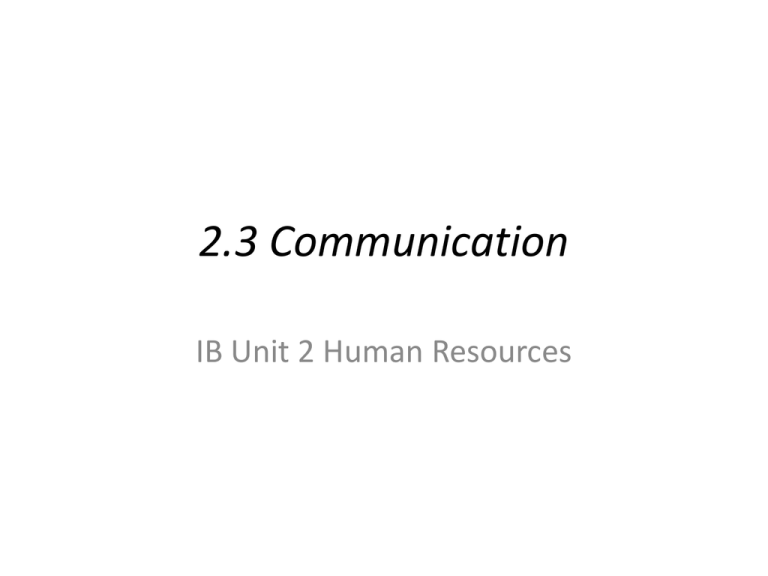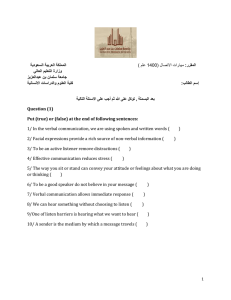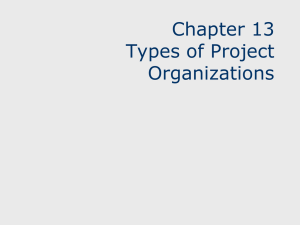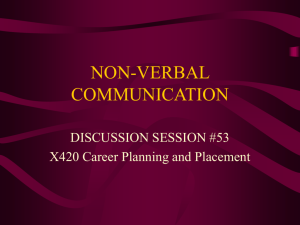2.3.4 Communication networks (hl)
advertisement

2.3 Communication IB Unit 2 Human Resources 2.3 Communication – verbal and non verbal communication methods IB Unit 2 Human Resources Lesson objectives • By the end of the lesson, students should be able to: – Define the different methods of communication: oral, written, visual, non verbal. – Analyse the advantages and disadvantages for each method – Identify different methods of communication Introduction - starter Communication is the transfer of information from one party to another. The purpose or objective of communication include: Instructing, clarifying, interpreting, notifying, warning, receiving, giving feedback, reviewing and to inform. Effective communication is vital so that Staff are aware of their roles and expectations Managers can gather and act upon feedback from employees, customers and other stakeholders. Remember! We mentioned Poor Communication As a Factor Which Can Lead to Low Motivation & Diseconomies of Scale Communication Marcouse 2008 Good communication Oral communication • Talking and listening to each other. Oral communication is fast because the sender and receiver are in direct contact with each other. When something is not understood, questions can be asked, i.e. feedback and clarification can be gathered. • Whether the a message is communicated well orally will depend on how good a speaker the sender is. Such as their use of jargon or their tone of voice. – When a person gives instructions to others, such as a manager announcing a major change in the organisation. – When people discuss problems – Business meetings, which are formal and follow an agenda – Job interviews – Job appraisals and feedback. – Oral presentations – When people are simply talking to each other. Activity – What mood are you in?! Advantages and disadvantages of oral communication Advantages Detailed questions can be asked Questions can be answered without delay There is low cost Some oral methods are a good way to judge an employee’s ability to communicate Tone of voice can be judged Advantages and disadvantages of oral communication Disadvantages The information may not all be truthful There is usually no permanent record of the conversation for future reference Confidential messages may be difficult to communicate verbally, especially when many people are involved. Meetings and interviews can be very time consuming. Mood and tone of voice may cause a barrier to communicating the message effectively Non-verbal communication • This includes written, visual communication and ICT. • Letters Advantages – Can be kept for future _________(9) Reference – Can be used for internal communication – Can be time consuming and may take time to receive a _________ Response (8). Non-verbal communication • Memorandum (memo) – A formal typed note or handwritten – Used for internal purposes – Short and specific • Notices – Are used when a message needs to reach a range of people, perhaps by postings on staff notice boards or on a company website. – Can be formal such as notices highlighting training opportunities or fire evacuation procedures. – Can contain a lot of formal information that can be left as a reminder to staff – However not confidential and old notices can be ignored Non-verbal communication • Reports – Formal method of communication written communication whereby information about something that has been researched is presented – They will contain: • A front title page which may include information such as the name of the author, the audience it is targeted at and the date. • An executive summary of what the report is about and the purpose of the research • A contents page with page numbering • An introduction to the report • Parts of the report to be separated by section headings • Conclusions and perhaps recommendations • A bibliography listing all sources of reference • An appendix with supplementary evidence such as quantitative research data. Non-verbal communication • Executive summaries – The increase in the amount of information available has made the executive summary more important. – A condensed version of the report’s content • Scope and purpose of the report • Methodology • Main results and findings • Conclusions and recommendations – The reader of the executive summary is often the decision maker who may have to decide on the course of action based on the report. – They must be accurate as a stand alone document as managers may make decisions solely based on this and not read the original report. Non-verbal communication • Abstracts – Abstracts are similar to executive summaries. – However, they do not directly provide any recommendations to the decision maker – Not as long as an executive summary • Research proposal – A planning document. It sets out the key issues to be investigated in a Report. – The proposal will contain details of the primary and secondary research to be undertaken and an action plan with dates and identification of any foreseeable problems. Visual communication • Advantages of visual communication : – Be understood easily – Communicate ideas quicker than words – Be often cheaper to produce than a full page of words – Cater for visual learners – May have a longer lasting impact • Examples include – – – – – – – – – – Bar charts Pie charts Line graphs Histograms Photographs Symbols Tables Maps Sketches Diagrams 2.3 Communication Networks Learning Objectives • • • • Barriers to Communication Formal and Informal Communication Technological Communication Factors influencing the choice of Communication • Types of Communication Networks Formal and informal communication channels – The term channel of communication is the method of communication. – For example in order to announce an end-of-season sale, managers in a large retail business may choose television advertising. • Informal communication- refers to all unofficial channels of that exist among informal groups. – An example of informal communication is the grapevine, which is basically GOSSIP in the workplace. – Does informal communication help or hinder the business? Benefits of informal communication Can create a sense of belonging in the workplace. People from different departments can talk about non work related issues at their lunch break. Can help workers support each other and deal with any anxiety they may have Ideas can be pooled that may not have occurred in more formal channels. Formal communication channels • These are official channels of communication • Written communication tends to relate to more formal channels of communication • Formal communication is directly related to work matters ICT • Email – Data is transmitted from one computer to another – Very fast because all the data is already in electronic form – Data can be sent to many recipients in a small space of time – High set up costs, ongoing costs. – Data not always secure – Technology may not always work, e.g. DAA WiFi! Factors influencing the choice of communication method • Personal preference- Some people may prefer to put things in writing, • Organisational structure- a taller structure will require more formal and structured systems • Security issues- hard copies maybe kept as well as computer files • Ease of use- How is easy is the form of communication you want to use? E.g. sending out flyers. • Size of business- a small business/flat organisation may rely on verbal/informal methods • Storage issues- An order placed by a customer needs to be recorded, whereas a conversation about a social event does not have to be documented • Location of sender and receiver- Time zone differences many influence whether to skype or just e-mail • Cost- Sea mail is cheaper than airmail What are the barriers to communication Barriers to effective communication – High costs – Technological breakdowns – Language – Accents – Jargon – Different cultures – Poor attitude • • • • • • Geographical location Internal politics Poor presentation skills Negative body language Chinese whispers Physiological barriers Lesson objectives • By the end of the lesson, students should be able to: – Understand the different communication networks which exist in an organisation – Evaluate the best communication network to use for a given situation Keywords • • • • Communication network Centralised networks Decentralised networks Wheel network • • • • Chain network Y-chain network Circle network All channel network Communication networks • A communication network shows the routes (links) that allow different parties to communicate a message, for example the actual communication structures within the business. • Networks can be used to examine the effectiveness of communication between people. • This is important for manager to know because the success of the organisation depends on the efficiency and productivity of its people. • There are two types of communication networks. – Centralised – Decentralised Centralised networks •Centralised methods of communication involve a key player that holds decision making power. Eg: •Wheel •Chain •Y-chain •With these methods information passes through a central person. •Wheel network- this method uses an experienced person or team leader at the hub. Others communicate primarily through the person in the centre. This method is useful when quick decision making is required. The person at the centre has control but others still have input. Chain networks •Used with organisations with a tall hierarchy •A large multinational will use this system to pass on information. Direction from the leader at the top of the chain Message can be distorted Y-Chain network •The Y-chain structure is similar to the chain method, except the information is passed onto several different parties. •Eg In a school the principal may pass on the information to her two deputy principles A large organisation can pass on information to shareholders and customers The central person can be overloaded People lower in the organisation can feel isolated Decentralised networks • Included the Circle and All Channel networks, where information passes from person to person. People feel valued as they have an input in planning and decision making. More ideas can be generated Decision making can be prolonged as there are many people involved in the process. Circle network • The circle communication network may be used for team-based tasks or a group of middle managers communication with one another. Good for complex problems No formal leader established All channel network • The all channel network (web network). • Allows people to communicate with whoever they feel necessary in order to meet their needs. • E.g. brainstorming during a meeting • Charles Handy suggests that this is the most ideal method when dealing with complex/ or open ended tasks.








